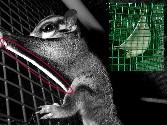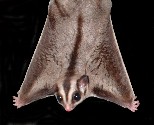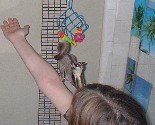Patagium
"Coming in for a landing... look out below!"
The Patagium, or whats commonly called the Gliding Membrane (or what I call "wings" :-),
stretch from wrist to ankle on each side of the Glider's body. It is folded close to the body when not in use.
They can Glide (volplane) at least 50 meters (or 150 ft.) Give or take a few feet.!

1. Leap... The sugar Glider leaps from a branch, thrust by its hind legs.
As it does, the gliding membranes spread out to support it.
2.Glide... By altering the shape and tension of the membranes and angle
of its tail, it is able to adjust the flow of air and steer a course.
3.Swoop... About 10' from its target and a split second before landing on
the tree trunk, the Sugar Glider swoops upward to slow down.
4.Touchdown... It makes a fourpoint landing on the tree trunk, sinking
claws into the bark to avoid being bounced off by the forceful impact.
Click on a photo to enlarge...
The Gliding Membrane (Patagium)


Coming in for a landing...lol.

* I personally do not use, or recommend, Glider Leashes/Harnesses. Im always afraid it might irritate their delicate Gliding Membranes.
Id hate to think it rubbed a raw spot or could possibly cause any type of injury. (In my opinion, a well bonded Glider shouldnt need a leash, if I think my 'kids' could possibly escape in public/etc, I just dont take them.
I prefer a nice secure bonding pouch/purse. (or in my little Amys case, a nice warm bra ride. ;-) If you notice any irritation, swelling, or general 'off' appearance of the Gliding Membrane/s, its best to have an experienced Vet have a look.
|






